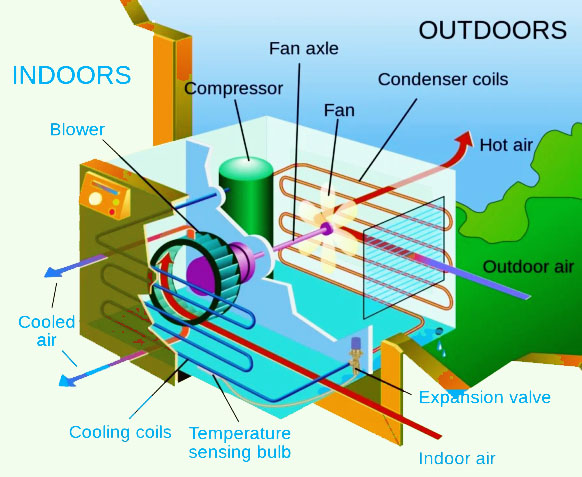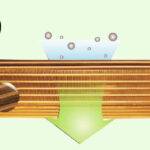Working Principle Of Air Conditioner
Air conditioners (AC) are synonymous with hot weather. They provide much needed relief during sweltering summer months. They keep indoors cool, reduce humidity, and allow us to go about our daily activities in comfort.
Table of Contents

In this article we are going to learn about the basic mechanism behind an air conditioner. We are going to do a deep-dive into the technology and parts of an air conditioner. We will also be taking a look at how an air conditioner compares with an air cooler. Let’s begin.
Technology Behind An Air Conditioner
The working principle of an air conditioner is based on a fundamental physical law of nature which is that when a liquid turns to a gas, it absorbs heat. This process is known as phase conversion and it uses up heat energy from the surroundings. An air conditioner relies on this physical law to convert a chemical compound known as refrigerant from its liquid to its gaseous state and back again to liquid to repeat the cycle.
A refrigerant is a chemical compound that evaporates easily at room temperature and this property is used by an air conditioner to remove heat from a room. An air conditioner consists of a closed system of serpentine coils inside which the refrigerant constantly evaporates and condenses in a cyclical manner. The process starts with the built-in thermostat sensing a rise in temperature.
A thermostat is a device that monitors the indoor temperature and directs the air conditioner to start working when it senses an increase in temperature. As soon as this signal is received, the motor or fan inside the air conditioner’s indoor unit starts pulling in hot air from the room and blowing it over the cold refrigerant-filled low-pressure evaporator coils. This causes the liquid inside the coils to absorb the heat and evaporate.
The air loses its heat, cools down and returns to the indoor space as chilled AC air. The evaporated refrigerant, on the other hand, moves into the compressor which subjects the gas to high pressure to condense it to liquid form. This second conversion releases a lot unwanted heat which is expelled into the outside environment using another set of coils known as condenser coils and a large fan.
As the gas liquefies, it cools down and the process starts all over again. This is how the temperature of a room drops as the refrigerant changes form from liquid to gas and gas to liquid over and over again.
Here, one needs to bear in mind that an air conditioner also acts as a dehumidifier. When an air conditioner removes heat from a room, it also removes some of the moisture present in the room air. This is because temperature is an important component of relative humidity, and one cannot reduce the heat energy trapped in a volume of humid air without simultaneously reducing humidity. That is why air conditioners have drainage pipes or water collection containers to remove excess water on humid days.
An air conditioner does not only cool air. It also monitors and controls the indoor temperature through a thermostat. The thermostat gauges the room temperature and based on the information provided by it, the air conditioner regulates its cooling intensity to achieve the set temperature.
Another function carried out by an air conditioner is air purification. It has air filters that trap airborne pollutants like particulate matter, animal and human hair to keep the indoor air clean and dust-free.
Now, let us analyze the different parts of an air conditioner and see how each part functions.
Parts of an air conditioner
An air conditioner consists of four major components:
- Evaporator coil
- Compressor
- Condenser coil
- Expansion valve

The indoor unit or cold side of the air conditioner consists of the evaporator coil and a blower/fan. The outdoor unit or hot side of an air conditioner contains the compressor, the condenser coil and a large exhaust fan. Between the hot and cold sections of the air conditioner is the expansion valve.
Evaporator Coil:
The evaporator coil is where the liquid refrigerant turn to gas. A fan draws in hot indoor air and blows it over the cold evaporator coils. The liquid inside absorbs the heat from the air and evaporates. The cooled air is then pushed back into the room and we enjoy it as the chilled breeze coming out of the air conditioner.
Compressor:
Once the refrigerant evaporates into a heated gas, it enters the compressor which is an electric pump. It increases the pressure and temperature of the refrigerant to compress it into a liquid.
Condenser Coil:
The compressor channels the gas into the condenser coil where it is converted back to a liquid. This process produces a lot of heat which is dissipated using a fan. The hot air is released into the outdoors and the compressed liquid starts moving towards the evaporator coil.
Expansion Valve:
Between the condenser coil and the evaporator coil is an apparatus known as expansion valve. Its job is to regulate the amount of compressed liquid refrigerant flowing into the evaporator coil from the condenser coil. Once the liquid enters the evaporator coil, it experiences a drop in pressure, expands and becomes a gas.
Expansion Valve:
Between the condenser coil and the evaporator coil is an apparatus known as expansion valve. Its job is to regulate the amount of compressed liquid refrigerant flowing into the evaporator coil from the condenser coil. Once the liquid enters the evaporator coil, it experiences a drop in pressure, expands and becomes a gas.
Apart from these four components, there are other parts inside an air conditioner that are equally important. These include the thermostat, the air filtration panels, the motor, the fan and the copper tubing that houses the refrigerant and provides it a safe path to journey between the indoor and outdoor units.
Please note that the components discussed above are standard for any air conditioner. But there may be variations. The manner in which they are housed inside the cabinet, or even outside of it for that matter, is bound to differ from one type of air conditioner to another.
For instance, a window air conditioner contains all the parts inside a compact all-inclusive window-mountable metal enclosure. A split air conditioner is slightly bigger and more complex. It has a distinct hot and cold side. The hot side stays outside the house and the cold side stays inside. The hot side contains the compressor, the condenser coil and the fan. The cold side contains the evaporator coil and the motor.
A central air conditioning system like the ones you see in malls and hotels is a much larger affair. It requires intricate ducting and masonry to deliver cool air to all the different parts of a building. Its exterior units are often housed in all-weather enclosures outside the building or on the roof. It also often shares the thermostat with the building’s heating system.
Refrigerants
CFC, or chlorofluorocarbon, or Freon as it is more commonly known, has always been the number one refrigerant used in air conditioners. But the group of chemicals has since been banned under the Montreal Protocol as it has been proven to cause depletion of the ozone layer.
Studies have shown how the chlorine enters the atmosphere and travels to the upper atmosphere where it triggers a chain reaction which ultimately destroys the stratospheric ozone. Hence, it is no longer used and has been replaced with HCFC or hydrochlorofluorocarbon. This compound, however, is only marginally better than CFC as it still contains chlorine.
The Indian government plans to phase out the use of HCFCs by the year 2030. Newer refrigerants like HFC or hydrofluorocarbon are more widely used. But even these chemicals are bad for the biosphere. They might not affect the ozone layer but still contribute to global warming. India plans to reduce the use of HFCs by 85% over the 2024-2026 levels by the year 2047.
The most environment-friendly refrigerants today are hydrocarbons like propane and iso-butane. They are completely halogen-free and have almost zero negative impact on the environment. In the India context, however, the technology surrounding these greener alternatives is still in the nascent stage.
The government and the private sector need to invest more in R&D and work cohesively if the country is to successfully transition into cleaner refrigerants in the future.
Difference Between An Air Conditioner And An Air Cooler
An air conditioner cools air with the help of chemicals known as refrigerants whereas an air cooler cools air through evaporative cooling which only needs water.
An air conditioner can provide a constant comfortable indoor temperature as set by the user. Its cooling is not affected by the outside temperature. An air cooler can lower the indoor temperature to a certain level. Beyond that it cannot cool the air. Its cooling is dependent on the outside temperature.
An air conditioner is easy to use and requires very little maintenance. An air cooler needs to be refilled with water every one or two days depending on the use. The cooling pads and the tank also need to be cleaned once every one or two months.
An air conditioner consumes a lot of electricity but an air cooler does not.
An air conditioner is ideal for hot and humid weather, whereas an air cooler is great for hot and dry weather.
Pro Tips : Air conditioning systems are better option for humid summers in India.

